- Scientific name: Erora laeta
- Species of Greatest Conservation Need (MA State Wildlife Action Plan)
- Threatened (MA Endangered Species Act)
Description
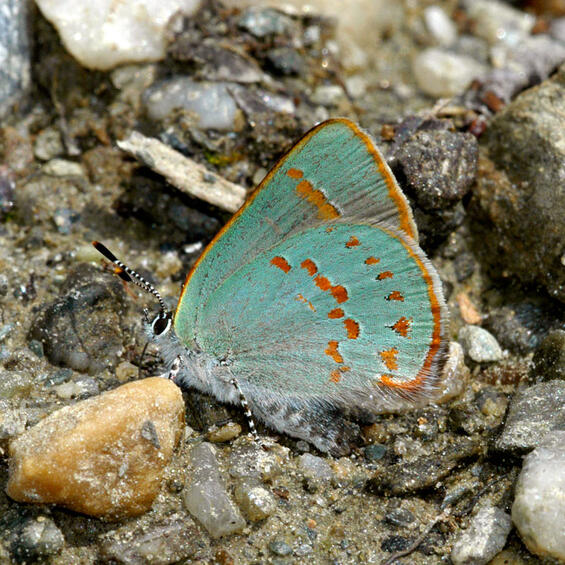
Early hairstreak (Erora laeta), resting position
The early hairstreak (Erora laeta) is a lycaenid butterfly with a wingspan of 23-31 mm (0.9-1.2 in). Like most gossamer-wings, the early hairstreak rests with wings folded above its back. The upper sides of the wings, hidden in this position, are iridescent blue with black margins in the female; they are mostly black in the male, with blue only at the outer angle of the hind wing. The undersides of the wings are lime green with bright orange spots and margins. Unlike many other hairstreaks, the hind wings have no tails.
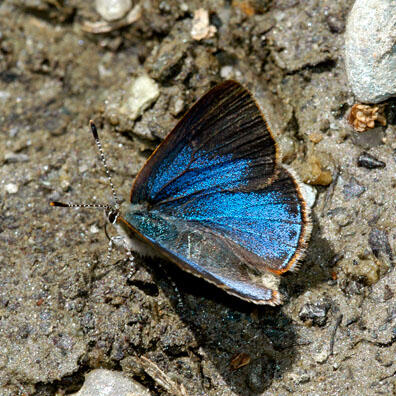
Upper side (female)
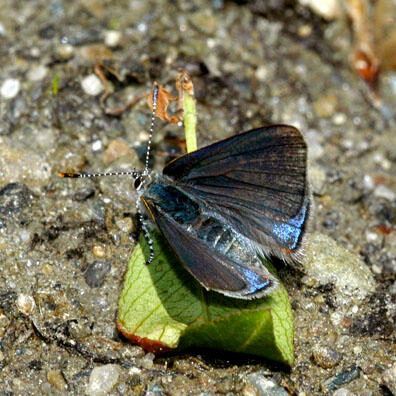
Upper side (male)
Life cycle and behavior

In Massachusetts, early hairstreak butterflies fly from mid-May to mid-June, occasionally into late June. Massachusetts records in July and early August may represent a partial second brood, but these records are very few in number. Adult butterflies are most readily observed while “puddling” on bare ground along dirt roads, paths, and ridge tops. In Massachusetts, the early hairstreak has been observed nectaring at flowers of blackberry (Rubus) (Leahy et al. 2006), as well as strawberry (Fragaria), black cherry (Prunus serotina), and others. Larvae feed on the flowers, developing fruits, and leaves of beech trees (Fagus grandifolia). The pupa overwinters.
Distribution and abundance
The early hairstreak ranges from Nova Scotia south to northern New Jersey, and west to northern Michigan, Wisconsin, and Ohio, also extending south in the Appalachian Mountains (at elevation) to northern Georgia (Opler 1998). In Massachusetts, the early hairstreak is known from Berkshire and Franklin Counties.
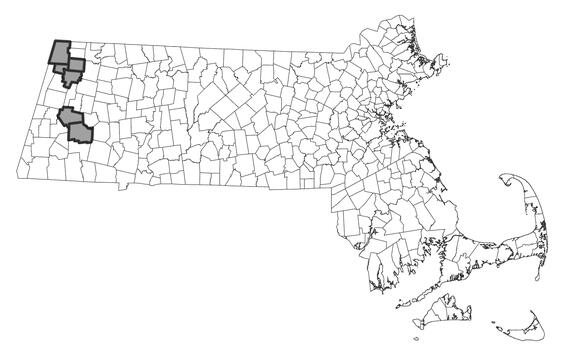
Distribution in Massachusetts.
1999-2024
Based on records in the Natural Heritage Database.
Habitat
The early hairstreak inhabits northern hardwood forest with beech trees, and associated openings such as roadsides and field margins where adults seek nectar at flowers.
Healthy habitats are vital for supporting native wildlife and plants. Explore habitats and learn about conservation and restoration in Massachusetts.
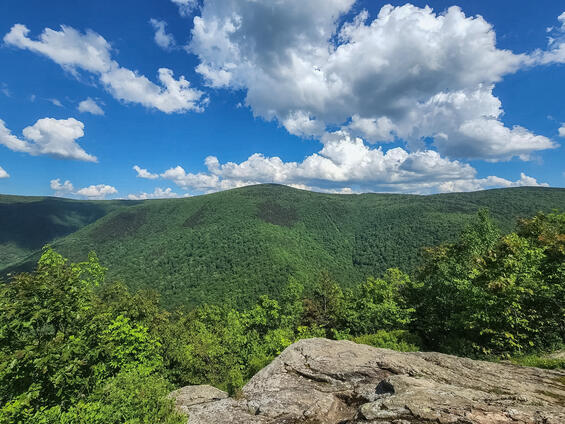
Northern hardwood forest with beech trees, habitat for the early hairstreak. Habitat managed by DCR at Mount Greylock State Reservation.
Threats
The early hairstreak is threatened by loss and fragmentation of northern hardwood forest as a result of development and clear-cut timber harvest. Loss of beech trees to beech bark disease or beech leaf disease are threats. Beech bark disease occurs when bark damaged by the introduced beech scale insect (Cryptococcus fagisuga) subsequently becomes infected with fungi (Nectria spp.). Beech leaf disease is likely caused by the introduced nematode Litylenchus crenatae mccannii.Other potential threats include introduced generalist parasitoids and aerial insecticide spraying. The early hairstreak is a northern species; south of New Jersey, it only occurs at elevation in the Appalachian Mountains. Therefore, it is vulnerable to a warming climate. Northward range expansion may be possible, though this has not yet been documented.
Conservation
Land protection and habitat management are the primary conservation needs of this species in Massachusetts. In particular, northern hardwood forest with beech trees should be conserved, restored, and managed to maintain habitat for this species and other species dependent on such habitat.
Survey and monitoring
The distribution of the early hairstreak in Massachusetts is relatively well documented. Known populations of this species should be surveyed to document persistence at least once every 25 years; every 10 years is more desirable when practicable.
Management
Management of northern hardwood forest benefits a suite of species, and habitat condition should be monitored and management adapted as needed. With the threats of beech bark disease and beech leaf disease, silviculture of beech to promote a diversity of age classes, from saplings to mature trees, is of particular importance.
Research needs
The natural history and conservation needs of the early hairstreak are relatively well known. However, the future effects of a warming climate on this species are unpredictable and should be documented.
References
Leahy, C.W., B. Cassie, and R.K. Walton (eds.). 2006. Massachusetts Butterfly Atlas 1986-1990. Massachusetts Audubon Society, Lincoln, Massachusetts. http://www.massaudubon.org/butterflyatlas.
Opler, P.A. 1998. A Field Guide to Eastern Butterflies. Peterson Field Guide Series. Houghton Mifflin, Boston, Massachusetts. 486 pp.
Contact
| Date published: | March 21, 2025 |
|---|